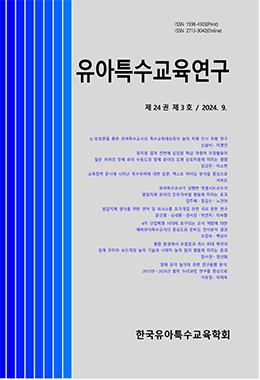본 연구는 발달지체 영아를 위한 언어 및 의사소통 조기개입 관련 국외 연구를 분석함으로써 국내 발달지체 영아의 언어 및 의사소통 발달을 위한 연구 방향 및 시사점을 모색하기 위해 실시하였다. 이를 위하여 2023년까지 국외에 발표된 총 12편의 언어 및 의사소통 조기개입 관련 연구를 선정하여 개괄적인 연구 동향, 언어 및 의사소통 조기개입의 특성과 성과를 분석하였으며, 그 결과는 다음과 같다. 첫째, 발달지체 영아의 언어 및 의사소통 조기개입 연구는 주로 단일대상연구를 사용하였으며, 비구어 및 1-2단어 수준의 24~36개월 영아를 대상으로 가장 많이 실시되었다. 둘째, 중재는 부모/교사 교육과 영아 대상 중재를 동시에 진행한 연구와 영아 대상 중재만을 실시한 연구로 분류하였다. 중재 방법으로는 환경 교수가 주로 사용되었으며, 구체적인 교수전략으로는 중재자의 시범이 가장 많았다. 부모 및 교사교육은 강의식 정보전달 및 습득한 정보나 전략을 역할극과 퀴즈 등의 방식으로 연습해 보는 방법을 활용한 연구가 가장 많았다. 셋째, 단일대상연구의 경우 의사소통 시작행동, 의사소통 반응행동, 발성/몸짓, 대체의사소통 등 주로 의사소통 행동을, 집단설계연구에서는 발화단어 수, 발화복잡성, 발화명료도, 언어발달지수 등 주로 언어적 특성을 측정하였다. 본 연구의 결과를 기반으로 발달지체 영아의 언어 및 의사소통 조기개입에 대한 시사점과 후속 연구의 방향에 대해 논의하였다.
This study explored research directions and implications for language and communication development in young children with developmental delays in South Korea by analyzing 12 international studies on early intervention published up to 2023. Key findings include: First, studies primarily used single-subject research designs targeting children aged 24 to 36 months with non-verbal infants and those using 1-2 word levels. Second, the interventions were classified into two categories: studies that implemented both parent/teacher training and interventions for infants simultaneously, and studies that focused solely on interventions for infants. The primary method was environmental teaching, with the most frequently used specific teaching strategy being the modeling. Third, in single-subject research, primarily communication behaviors such as initiation of communication, response to communication, vocalization/gestures, and alternative communication were measured. In group design studies, primarily linguistic characteristics such as the number of spoken words, complexity of speech, clarity of speech, and language development index were assessed. The study discusses implications for early intervention and future research directions in this field.




